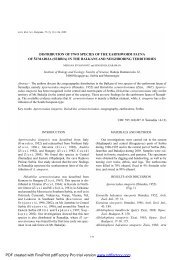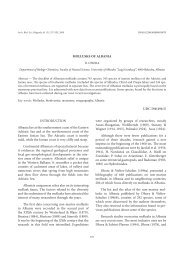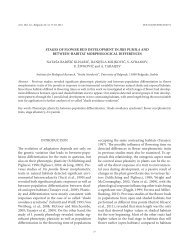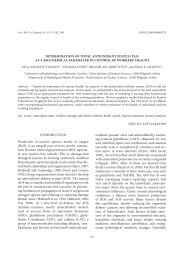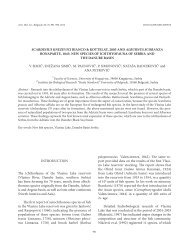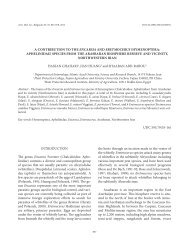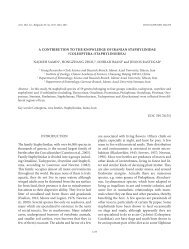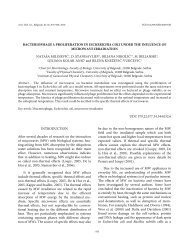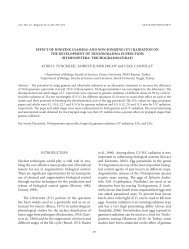Diatom species composition of the Nišava river and its tributaries ...
Diatom species composition of the Nišava river and its tributaries ...
Diatom species composition of the Nišava river and its tributaries ...
You also want an ePaper? Increase the reach of your titles
YUMPU automatically turns print PDFs into web optimized ePapers that Google loves.
Arch. Biol. Sci., Belgrade, 64 (3), 1127-1140, 2012 DOI:10.2298/ABS1203127A<br />
DIATOM SPECIES COMPOSITION OF THE NIŠAVA RIVER AND ITS TRIBUTARIES JERMA<br />
AND TEMSKA RIVERS (SOUTHERN SERBIA)<br />
JELENA Z. ANDREJIĆ, JELENA KRIZMANIĆ <strong>and</strong> M. CVIJAN<br />
Institute for Botany <strong>and</strong> Botanical Garden “Jevremovac”, Faculty <strong>of</strong> Biology, University <strong>of</strong> Belgrade, 11000 Belgrade, Serbia<br />
Abstract – The main objective <strong>of</strong> this paper is to report <strong>the</strong> diatom taxa identified from <strong>the</strong> <strong>Nišava</strong> River <strong>and</strong> <strong>its</strong> <strong>tributaries</strong>,<br />
<strong>the</strong> Jerma <strong>and</strong> Temska <strong>river</strong>s. The study area included 11 sampling sites along <strong>the</strong> <strong>Nišava</strong> River, with one site on <strong>the</strong> Jerma<br />
River <strong>and</strong> one on <strong>the</strong> Temska River. Monthly samples (from stones, sediments <strong>and</strong> macrophytes) were collected from May<br />
2008 to May 2009. <strong>Diatom</strong> frustules were cleaned with chemical agents, <strong>and</strong> mounted on permanent slides. In total, 194<br />
diatom taxa were identified. The most <strong>species</strong> rich genera are Navicula (25), Nitzschia (17) <strong>and</strong> Gomphonema (13), while<br />
o<strong>the</strong>r genera are presented with one or more <strong>species</strong>. Detailed floristic analysis <strong>of</strong> <strong>the</strong> benthic diatom flora has not been<br />
conducted before on <strong>the</strong>se <strong>river</strong>s. Therefore, this paper provides a baseline for future research.<br />
Key words: <strong>Diatom</strong>s, <strong>Nišava</strong> River, Jerma, Temska River, <strong>species</strong> <strong>composition</strong>, Serbia<br />
INTRODUCTION<br />
Benthic algae are primary producers in streams<br />
<strong>and</strong> are <strong>the</strong> main source <strong>of</strong> energy in a food chain<br />
for aquatic organisms (Biggs, 1996). <strong>Diatom</strong>s are <strong>of</strong>ten<br />
<strong>the</strong> dominant group <strong>of</strong> algae in streams (Dodds,<br />
2002). In this regard, <strong>the</strong>ir taxonomic diversity is an<br />
important aspect <strong>of</strong> an aquatic community because<br />
it reflects <strong>the</strong> biodiversity <strong>and</strong> stability <strong>of</strong> a <strong>river</strong> ecosystem.<br />
The <strong>Nišava</strong> River is <strong>the</strong> biggest tributary <strong>of</strong><br />
<strong>the</strong> South Morava River. It belongs to <strong>the</strong> Black<br />
Sea drainage basin, originates in <strong>the</strong> Stara Planina<br />
Mountains, arising from <strong>the</strong> Ginska <strong>and</strong> Vrbnica <strong>river</strong>s<br />
at an elevation <strong>of</strong> 640 m, near <strong>the</strong> village Toden in<br />
Bulgaria. It enters Serbia 6 km from <strong>the</strong> city <strong>of</strong> Dimitrovgrad,<br />
flows generally westward, until it empties<br />
into <strong>the</strong> South Morava River, about 10 km from <strong>the</strong><br />
city <strong>of</strong> Niš. Along with Ginska River, it is 202 km<br />
long, with a catchment area <strong>of</strong> 4068 km 2 (<strong>the</strong> Serbian<br />
1127<br />
part is 151 km long, <strong>the</strong> catchment area is 2971.5<br />
km 2 ). Major <strong>tributaries</strong> <strong>of</strong> <strong>the</strong> <strong>Nišava</strong> River are <strong>the</strong><br />
Temska, Visočica <strong>and</strong> Jerma <strong>river</strong>s (Gavrilović <strong>and</strong><br />
Dukić, 2002). The <strong>Nišava</strong> River is an important water<br />
resource for Niš (Branković et al., 2007), though<br />
<strong>the</strong> negative impact <strong>of</strong> Niš’s wastewater has been reported<br />
by Branković et al. (2009). Pirot’s communal<br />
waste is also a major pollution point (Miljojković et<br />
al., 2010).<br />
Martinović-Vitanović (1985) has reported a<br />
few plankton diatom <strong>species</strong> from <strong>the</strong> <strong>Nišava</strong> River,<br />
as part <strong>of</strong> <strong>the</strong> South Morava drainage basin, while<br />
Branković et al. (2007) <strong>and</strong> Trajković el at. (2008)<br />
have reported 17 benthic diatom <strong>species</strong> from Sićevo<br />
<strong>and</strong> Prosek localities.<br />
The main objective <strong>of</strong> <strong>the</strong> manuscript is to<br />
present 194 diatom taxa identified from 13 sampling<br />
sites in order to create baseline date for future<br />
research. The diatom flora is described <strong>and</strong> <strong>the</strong>
1128 JELENA Z. ANDREJIĆ ET AL.<br />
physico-chemical properties <strong>of</strong> <strong>the</strong> water are presented.<br />
MATERIALS AND METHODS<br />
The study area included 11 sampling sites along <strong>the</strong><br />
<strong>Nišava</strong> River, with one site on <strong>the</strong> Jerma River <strong>and</strong><br />
one on <strong>the</strong> Temska River (see Fig. 1). The sampling<br />
sites were located before <strong>and</strong> after <strong>the</strong> cities <strong>of</strong> Dimitrovgrad,<br />
Pirot, Bela Palanka <strong>and</strong> Niš, <strong>and</strong> before<br />
<strong>and</strong> after <strong>the</strong> Jerma River estuary.<br />
Fig.1. Distribution <strong>of</strong> sampling sites along <strong>the</strong> <strong>Nišava</strong> River (1-<br />
11). J-sampling site at <strong>the</strong> Jerma River, T-sampling site at <strong>the</strong><br />
Temska River.<br />
Sampling was done monthly from May 2008 to<br />
May 2009, except in November 2008 <strong>and</strong> February<br />
2009 due to flooding. The material for studying <strong>the</strong><br />
benthic diatom community was collected from three<br />
different microhabitats: cobbles or boulder (epilithon),<br />
macroalgae <strong>and</strong> vascular plants (epiphyton)<br />
<strong>and</strong> sediments (epipelon). A total amount <strong>of</strong> 326<br />
samples from <strong>the</strong> epilithon (114), epiphyton (88) <strong>and</strong><br />
epipelon (124) microhabitats were analyzed. Benthic<br />
diatoms were collected from stones <strong>and</strong> macrophytes<br />
by cleaning with a toothbrush, <strong>and</strong> sediments by<br />
means <strong>of</strong> a glass pipette. The algological material<br />
was preserved in 4% formalin. Conductivity, pH <strong>and</strong><br />
water temperature were measured with a Lovibond<br />
Multimeter WTW 340i at each sampling site. Ammonium<br />
ions, nitrates, nitrites, phosphates, silicates<br />
<strong>and</strong> total hardness were measured using a Lovibond<br />
photometer PC Multidirect. Algological samples were<br />
transported <strong>and</strong> processed at <strong>the</strong> Institute for Botany<br />
<strong>and</strong> Botanical Garden, Belgrade. The material was<br />
digested using concentrated sulfuric acid (H2SO4),<br />
potassium permanganate (KMnO4) <strong>and</strong> oxalic acid<br />
(Krammer <strong>and</strong> Lange-Bertalot 1986), <strong>the</strong>n rinsed<br />
repeatedly with deionized water until <strong>the</strong> pH was approximately<br />
7, <strong>and</strong> mounted on slides with Naphrax®<br />
mounting medium. Microscopic examination <strong>of</strong> <strong>the</strong><br />
permanent slides was done using Zeiss Axio-Imager<br />
M1 microscope, <strong>and</strong> processed with AxioImager Vision<br />
v. 4.8 s<strong>of</strong>tware. Identification <strong>of</strong> <strong>the</strong> valves was<br />
done according to Krammer <strong>and</strong> Lange-Bertalot<br />
(1986, 1988, 1991, 2004), Krammer (1997, 1997a,<br />
2000, 2002, 2003), Lange-Bertalot (1993, 2001), Cantonati<br />
et al. 2010, Mann et al. (2004, 2008), Reichardt<br />
(1997, 1999, 2001), Reichardt <strong>and</strong> Lange-Bertalot<br />
1991, Cox (2003) <strong>and</strong> Levkov <strong>and</strong> Luc (2010).<br />
RESULTS AND DISCUSSION<br />
Physico-chemical analysis <strong>of</strong> water<br />
In <strong>the</strong> <strong>Nišava</strong> River <strong>the</strong> temperature gradient was<br />
<strong>the</strong> highest (0.1-27.1°C), while in <strong>the</strong> Jerma <strong>and</strong><br />
Temska <strong>river</strong>s it was lowest (1.3-16.7°C for Jerma,<br />
<strong>and</strong> 10-18.4°C for Temska). Mean water temperatures<br />
in <strong>the</strong> <strong>Nišava</strong> River increase from locality no.1<br />
to locality no. 11, because <strong>the</strong> upper <strong>and</strong> middle<br />
course <strong>of</strong> <strong>the</strong> <strong>river</strong> is located in a mountain region,<br />
while <strong>the</strong> lower course is located in a valley. The pH<br />
varied within four un<strong>its</strong> for <strong>the</strong> <strong>Nišava</strong> River, from<br />
moderately acidic to slightly alkaline (4.5-8.5),<br />
while in <strong>the</strong> Jerma <strong>and</strong> Temska <strong>river</strong>s it varied within<br />
two un<strong>its</strong> (5.54-7.5, 6.5-8.5). Conductivity level<br />
variations were greater in <strong>the</strong> <strong>Nišava</strong> River (289-<br />
986 µS/cm), compared to <strong>the</strong> Jerma <strong>and</strong> Temska<br />
<strong>river</strong>s, where conductivity varied less (319-426 µS/<br />
cm, 175-254 µS/cm). In general, <strong>the</strong> amount <strong>of</strong> nutrients<br />
(nitrates, nitrites, silicates, ammonium ion<br />
<strong>and</strong> phosphates) tended to be higher downstream<br />
<strong>of</strong> wastewater discharges (Dimitrovgrad, Pirot <strong>and</strong><br />
Niš cities), particularly at sites nos. 2, 6 <strong>and</strong> 11. Total<br />
hardness varied within 43 un<strong>its</strong> for <strong>the</strong> <strong>Nišava</strong><br />
River (4-47), in comparison to <strong>the</strong> Jerma <strong>and</strong> Tem-
DIATOM SPECIES COMPOSITION OF THE NIŠAVA RIVER AND ITS TRIBUTARIES JERMA AND TEMSKA RIVERS 1129<br />
Fig. 2. Minimal, maximal <strong>and</strong> mean values <strong>of</strong> measured environmental variables in <strong>the</strong> <strong>Nišava</strong>, Jerma <strong>and</strong> Temska Rivers
1130 JELENA Z. ANDREJIĆ ET AL.<br />
Table 1. List <strong>of</strong> <strong>the</strong> benthic diatoms, found in <strong>the</strong> <strong>Nišava</strong>, Jerma <strong>and</strong> Temska Rivers. Species names are listed in alphabetical order. Abbreviations:<br />
N-<strong>Nišava</strong> River, J-Jerma River, T-Temska River. The symbol +͵ represents <strong>the</strong> presence <strong>of</strong> a <strong>species</strong>, <strong>and</strong> -͵ represents <strong>the</strong><br />
absence <strong>of</strong> a <strong>species</strong>.<br />
No. TAXON N J T<br />
1<br />
Achnan<strong>the</strong>s coarctata (Brébisson) Grunow + - -<br />
2<br />
Achnanthidium minutissimum (Kützing) Czarnecki + + +<br />
3 A. pyrenaicum (Hustedt) Kobayasi + + +<br />
4 Actinocyclus normanii (Gregory) Hustedt + - -<br />
5 Amphipleura pellucida (Kützing) Kützing + + -<br />
6 Amphora copulata (Kützing) Schoeman & Archibald + + +<br />
7 A. inariensis Krammer + + -<br />
8 A. montana Krasske + + -<br />
9 A. normani Rabenhorst - + -<br />
10 A. ovalis (Kützing) Kützing + + +<br />
11 A. pediculus (Kützing) Grunow + + +<br />
12 Anomoeoneis sphaerophora (Ehrenberg) Pfitzer + - -<br />
13 Asterionella formosa Hassal 1850 + - -<br />
14 Aulacoseira sp.A + - -<br />
15 Caloneis amphisbaena (Bory) Cleve + + -<br />
16 C. bacillum (Grunow) Cleve + + -<br />
17 C. molaris (Grunow) Krammer + - +<br />
18 C. schumanniana (Grunow) Cleve + - -<br />
19 C. silicula (Ehrenberg) Cleve + + -<br />
20 Campylodiscus hibernicus Ehrenberg + - -<br />
21 Cocconeis disculus (Schumann) Cleve + - -<br />
22 C. pediculus (Ehrenberg) + + +<br />
23 C. placentula (Ehrenberg) + + +<br />
24 C. placentula var. pseudolineata Geitler - - +<br />
25 Craticula accomoda (Hustedt) Mann + - -<br />
26 C. ambigua (Ehrenberg) Mann + + +<br />
27 C.cuspidata (Kützing) Mann + + -<br />
28 Cyclotella distinguenda Hustedt + - -<br />
29 C. meneghiniana Kützing + + +<br />
30 C. ocellata Pantocsek + - +<br />
31 Cymatopleura elliptica (Brébisson) Smith + + +<br />
32 C. solea (Brébisson) Smith + + +
Table 1. Continued<br />
DIATOM SPECIES COMPOSITION OF THE NIŠAVA RIVER AND ITS TRIBUTARIES JERMA AND TEMSKA RIVERS 1131<br />
No. TAXON N J T<br />
33 C.solea var. apiculata (Smith) Ralfs + + +<br />
34 Cymbella compacta Østrup + + +<br />
35 C. cymbiformis Agardh + + +<br />
36 C. excisa Kützing + + +<br />
37 C. lanceolata (Ehrenberg) Kirchner + + +<br />
38 C. preparva Krammer - - +<br />
39 C. subcistula Krammer + - -<br />
40 C. tumida (Brébisson) van Heurck + + +<br />
41 Cymbopleura amphicephala (Nägeli) Krammer + + +<br />
42 C. cuspidata (Kützing) Krammer + - -<br />
43 Denticula kuetzingii Grunow + - -<br />
44 D. tenuis Kützing + - -<br />
45 Diadesmis contenta (Grunow) Mann + - +<br />
46 <strong>Diatom</strong>a ehrenbergii Kützing + + +<br />
47 D. mesodon (Ehrenberg) Kützing + - +<br />
48 D. moniliformis Kützing + + +<br />
49 D. vulgaris Bory + + +<br />
50 Diploneis marginestriata Hustedt + - -<br />
51 D.s oblongella (Nägeli) Cleve-Euler + - -<br />
52 D. oculata (Brébisson) Cleve + - -<br />
53 D. ovalis (Hilse) Cleve + - -<br />
54 Ellerbeckia arenaria (Moore) Crawford - + -<br />
55 Encyonema caespitosum Kützing + - +<br />
56<br />
E. minutiformae Krammer<br />
+ - +<br />
57 E. prostratum Kützing + + +<br />
58 E. silesacum (Bleisch) Mann + - +<br />
59 E. ventricosum (Agardh) Grunow + + +<br />
60 Encyonopsis subminuta Krammer & Reichardt + - -<br />
61 Eolimna minima (Grunow) Lange-Bertalot + + +<br />
62 E. subminuscula (Manguin) Moser,L.-Bert.&Metz. + + +<br />
63 Epi<strong>the</strong>mia sorex Kützing + - -<br />
64 Eunotia pectinalis f. undulata (J.Ralfs) Berg - - +<br />
65 Fallacia monoculata (Hustedt) Mann + - -
1132 JELENA Z. ANDREJIĆ ET AL.<br />
Table 1. Continued<br />
No. TAXON N J T<br />
66 F. pygmaea (Kützing) Stickle & Mann + + -<br />
67 F. subhamulata (Grunow) Mann + + +<br />
68 Fragilaria biceps (Kützing) Lange-Bertalot + + -<br />
69 F.a capucina Desmazières + - -<br />
70 F.a capucina var. capitellata (Grunow) Lange-Bertalot + + +<br />
71 F.a vaucheriae (Kützing) Petersen + - +<br />
72 Frustulia vulgaris (Thwaites) De Toni + + -<br />
73 Geissleria decussis (Østrup) Lange-Bertalot & Metzeltin + + +<br />
74 Gomphonema acuminatum Ehrenberg + - -<br />
75 G. aff. affine Kützing + + -<br />
76 G. angustatum (Kützing) Rabenhorst + - -<br />
77 G. augur Ehrenberg + - -<br />
78 G. capitatum Ehrenberg + + +<br />
79 G. italicum Kützing + - -<br />
80 G. micropus Kützing + + -<br />
81 G. minutum (Agardh) Agardh + + +<br />
82 G. olivaceolacuum (L.-B.&Reich.)L.-B.&Reich. + - -<br />
83 G. olivaceum (Hornemann) Kützing + + +<br />
84 G. parvulum (Kützing) Kützing + - +<br />
85 G. pumilum (Grunow) Reich. & L.-Bertalot + + +<br />
86 G. tergestinum (Grunow) Fricke + + -<br />
87 Gyrosigma acuminatum (Kützing) Rabenhorst + + +<br />
88 G. attenuatum (Kützing) Rabenhorst + + +<br />
89 G. scalproides (Rabenhorst) Cleve + + -<br />
90 Hannaea arcus (Ehrenberg) Patrick + + +<br />
91 Hantzschia amphioxys (Ehrenberg) Grunow + + -<br />
92 Hippodonta capitata (Ehrenberg) L.-Bert.,Metz.&Witko. + + +<br />
93 Karayevia ploenensis (Hustedt) Bukhtiyarova - + -<br />
94 Luticola dismutica (Hustedt) Mann + - -<br />
95 L. goeppertiana (Bleisch) Mann + - -<br />
96 L. mutica (Kützing) Mann + - -<br />
97 L. muticopsis (Van Heurck) Mann + - -<br />
98 Mayamaea atomus (Kützing) Lange-Bertalot + + +
Table 1. Continued<br />
DIATOM SPECIES COMPOSITION OF THE NIŠAVA RIVER AND ITS TRIBUTARIES JERMA AND TEMSKA RIVERS 1133<br />
No. TAXON N J T<br />
99 Melosira varians Agardh + + +<br />
100 Meridion circulare (Greville) Agardh + + +<br />
101 M. constrictum Ralfs - + +<br />
102 Navicula amphiceropsis Lange-Bertalot & Rumrich + + +<br />
103 N. antonii Lange-Bertalot & Rumrich + + +<br />
104<br />
N. capitoradiata Germain + + +<br />
105 N. cari Ehrenberg + - -<br />
106 N. cryptocephala Kützing + - +<br />
107 N. cryptotenella Lange-Bertalot in Krammer + + +<br />
108 N. erifuga Lange-Bertalot in Krammer + - -<br />
109 N. gregaria Donkin + + +<br />
110 N. kotschyi Grunow + - -<br />
111 N. lanceolata (Agardh) Ehrenberg + + -<br />
112 N. novaesiberica Lange-Bertalot + - -<br />
113 N. oblonga (Kützing) Kützing - + -<br />
114 N. pseudotenelloides Krasske + - -<br />
115 N. radiosa Kützing + + +<br />
116 N. reichardtiana Lange-Bertalot + + +<br />
117 N. reichardtii (Grunow) Grunow - - +<br />
118 N. rostellata Kützing + - -<br />
119 N. tenelloides Hustedt - + -<br />
120 N. tripunctata (Müller) Bory de Saint-Vincent + + +<br />
121 N. trivialis Lange-Bertalot + - -<br />
122 N. upsaliensis (Grunow) Peragallo + + -<br />
123 N. veneta Kützing + + +<br />
124 N. viridula (Kützing) Ehrenberg + + +<br />
125 N. viridulacalcis Lange-Bertalot + + +<br />
126 Neidiomorpha binodiformis (Krammer) Lange-Bertalot & Cantonati + + -<br />
127 Neidium ampliatum (Ehrenberg) Krammer + - -<br />
128 N. dubium (Ehenberg) Cleve + + +<br />
129 N.dubium f. constrictum Hustedt + - -<br />
130 Nitzschia acicularis (Kützing) W.Smith + + +<br />
131 N. capitellata Hustedt in Schmidt et al. + + -
1134 JELENA Z. ANDREJIĆ ET AL.<br />
Table 1. Continued<br />
No. TAXON N J T<br />
132 N. clausii Hantzsch + - -<br />
133 N. dissipata (Kützing) Grunow + + +<br />
134 N. dubia Smith + + -<br />
135 N. fonticola Grunow in Cleve & Möller + + +<br />
136 N. heufleriana Grunow + + +<br />
137 N. inconspicua Grunow + - -<br />
138 N. linearis (Agardh) Smith + + +<br />
139 N. linearis var. tenuis (Smith) Grunow in Cleve & Grunow + + +<br />
140 N. palea (Kützing) W.Smith + + +<br />
141 N. pusilla Grunow + - -<br />
142 N. recta Hantzsch ex Rabenhorst + + +<br />
143 N. sigmoidea (Nitzsch) W.Smith + + +<br />
144 N. sinuata var. tabellaria (Grunow) Grunow in van Heurck + - -<br />
145 N. sociabilis Hustedt + + +<br />
146 N. vermicularis (Kützing) Hantzsch in Rabenhorst + + +<br />
147 Parlibellus protracta (Grunow) Witkowski, Lange-Bertalot & Metzeltin + - -<br />
148 Pinnularia borealis var. scalaris (Ehrenberg) Rabenhorst + - -<br />
149 P. borealis var. sublinearis Krammer - - +<br />
150 P. brebissonii (Kützing) Rabenhorst + - +<br />
151 P. obscuriformis Krammer + - -<br />
152 P. oriunda Krammer + - -<br />
153 P. subrupestris Krammer - - +<br />
154 P. undula (Schumann) Krammer - + -<br />
155 P. viridiformis Krammer + - -<br />
156 Placoneis clementis (Grunow) E.J. Cox + - -<br />
157 P.s paraelginensis Lange-Bertalot + + -<br />
158 P. placentula (Ehrenberg) Mereschkowsky + - -<br />
159 P. pseudanglica Cox + - -<br />
160 Planothidium dubium (Grunow) Round & Bukhtiyarova + - -<br />
161 P. frequentissimum (Lange-Bertalot) Lange-Bertalot + + +<br />
162 P. lanceolatum (Brébisson ex Kützing) Round & L.Bukhtiyarova 1996 + + +<br />
163 Puncticulata radiosa (Grunow) Hakansson + - +
Table 1. Continued<br />
DIATOM SPECIES COMPOSITION OF THE NIŠAVA RIVER AND ITS TRIBUTARIES JERMA AND TEMSKA RIVERS 1135<br />
No. TAXON N J T<br />
164 Reimeria sinuata (Gregory) Kociolek & Stoermer + + +<br />
165 Rhoicosphenia abbreviata (Agardh) Lange-Bertalot + + +<br />
166 Rhopalodia gibba (Ehrenberg) Otto Müller - + -<br />
167 R. operculata (C.Agardh) Håkanasson + - -<br />
168 Sellaphora bacilloides (Husted) Levkov, Krstic et. nakov + - -<br />
169 S. bacillum (Ehrenberg) Mann + + +<br />
170 S. capitata Mann & McDonald + + -<br />
171 S. lanceolata Mann & Droop + - -<br />
172 S.pupula (Kützing) Mereschkovsky + + +<br />
173 Stauroneis gracilis Ehrenberg + - -<br />
174 S. phoenicenteron (Nitzsch) Ehrenberg + + -<br />
175 S. smithii Grunow + + -<br />
176 Staurosira pinnata Ehrenberg + - -<br />
177 Stephanodiscus parvus Stoermer & Håkansson + - -<br />
178 Surirella angusta Kützing + + +<br />
179 S. bifrons Ehrenberg - + -<br />
180 S. brebissonii var. kuetzingii Krammer & Lange-Bertalot + + +<br />
181 S. linearis Smith - + -<br />
182 S. minuta Brébisson in Kützing + + +<br />
183 S. ovalis Brébisson + + -<br />
184 S. tenera Gregory - + +<br />
185 Synedrella parasitica (Smith) Round & Maidana + + -<br />
186 S. subconstricta (Grunow) Round & Maidana + + -<br />
187 Tryblionella angustata Smith + + +<br />
188 T. apiculata Gregory + + -<br />
189 T. calida (Grunow in Cleve & Grunow) Mann + - -<br />
190 T. gracilis Smith + - -<br />
191 T. hungarica (Grunow) Mann + + -<br />
192 T. salinarum (Grunow) Pantocsek + + -<br />
193 Ulnaria acus (Kützing) Aboal + + -<br />
194 U. ulna (Nitzsch) Compère + + +<br />
TOTAL 177 115 93<br />
PERCENTAGE (%) 91.2 59.3 47.9
1136 JELENA Z. ANDREJIĆ ET AL.<br />
ska Rivers where hardness varied within around<br />
10 un<strong>its</strong> (13-23, 6-15). The minimal, maximal <strong>and</strong><br />
mean values <strong>of</strong> measured environmental variables<br />
in <strong>the</strong> <strong>Nišava</strong>, Jerma <strong>and</strong> Temska Rivers are shown<br />
in Fig. 2.<br />
<strong>Diatom</strong> <strong>species</strong> <strong>composition</strong><br />
A total <strong>of</strong> 194 diatom taxa were identified in this investigation<br />
(Table 1): 177 in <strong>the</strong> <strong>Nišava</strong> River, 116 in<br />
<strong>the</strong> Jerma River <strong>and</strong> 92 in <strong>the</strong> Temska River. Of <strong>the</strong><br />
194 taxa, 69 occurred in all three <strong>river</strong>s. Several diatom<br />
taxa occurred in only one <strong>river</strong>: 57 in <strong>the</strong> <strong>Nišava</strong><br />
River, 9 in Jerma River <strong>and</strong> 6 in <strong>the</strong> Temska River.<br />
The most abundant genera were Navicula (25),<br />
Nitzschia (17) <strong>and</strong> Gomphonema (13); less abundant<br />
genera were Pinnularia (8), Surirella (7), Cymbella<br />
(7), Amphora (6), Tryblionella (6), Encyonema (5),<br />
Sellaphora (5), Caloneis (5), Cocconeis (4), <strong>Diatom</strong>a<br />
(4), Diploneis (4), Fragilaria (4), Luticola (4), Placoneis<br />
(4), Stauroneis (4), Craticula (3), Cyclotella (3),<br />
Cymatopleura (3), Fallacia (3), Gyrosigma (3), Neidium<br />
(3), <strong>and</strong> Planothidium (3). Two or a single <strong>species</strong><br />
(Table 2) presented o<strong>the</strong>r genera.<br />
The dominant <strong>species</strong> were: Achnanthidium<br />
minutissimum, A. pyrenaicum, Amphora copulata,<br />
Cocconeis placentula, Gomphonema minutum, G.<br />
pumilum, Navicula cryptotenella, N. reichardtiana,<br />
N. tripunctata, Nitzschia dissipata <strong>and</strong> N. fonticola.<br />
These <strong>species</strong> were abundantly-developing in mass<br />
<strong>and</strong> strongly predominating over <strong>the</strong> o<strong>the</strong>r diatom<br />
<strong>species</strong> in <strong>the</strong> community, <strong>and</strong> frequently-appearing<br />
in <strong>the</strong> majority <strong>of</strong> samples. Several diatom <strong>species</strong><br />
were also abundant, but only at individual sites:<br />
<strong>Diatom</strong>a moniliformis <strong>and</strong> D. vulgaris at site no. 1,<br />
Nitzschia palea at site no. 2, Navicula tripunctata at<br />
site no. 7, Cocconeis pediculus at sites no. 6 <strong>and</strong> 8,<br />
Eolimna subminuscula, Navicula capitoradiata <strong>and</strong><br />
Ulnaria ulna at site no. 11. The presence <strong>of</strong> plankton<br />
<strong>species</strong> such as Asterionella formosa <strong>and</strong> Cyclotella<br />
meneghiniana in <strong>the</strong> benthos was probably a result<br />
<strong>of</strong> drift from dams situated on <strong>the</strong> <strong>Nišava</strong> River. The<br />
highest <strong>species</strong> diversity was recorded at site no. 1,<br />
<strong>and</strong> lowest at site no. 5.<br />
The recorded <strong>composition</strong> <strong>of</strong> <strong>the</strong> benthic diatom<br />
community is typical <strong>of</strong> running water <strong>and</strong> is similar<br />
to <strong>the</strong> diatom communities from o<strong>the</strong>r <strong>river</strong>s in Serbia<br />
(Ržaničanin, 2004; Simić, 1996; Laušević, 1993;<br />
Nikitović, 1998; Tomašević, 2000; Jurišić, 2004).<br />
Similar to our study, Navicula was <strong>the</strong> most <strong>species</strong><br />
rich genus in <strong>the</strong> West Morava River (Jurišić, 2004),<br />
Trgoviški Timok River (Simić, 1996) <strong>and</strong> in <strong>the</strong><br />
Samokovska River (Laušević, 1993). Species belonging<br />
to <strong>the</strong> genera Navicula <strong>and</strong> Nitzschia are highly<br />
motile <strong>and</strong> capable <strong>of</strong> moving through sediments<br />
(Round, 1990). The high number <strong>of</strong> samples from<br />
epipelon might explain <strong>the</strong> high number <strong>of</strong> <strong>species</strong><br />
<strong>of</strong> <strong>the</strong> Navicula <strong>and</strong> Nitzchia genera in our study. The<br />
availability <strong>of</strong> <strong>the</strong>se microhabitats might play an important<br />
role in determining <strong>the</strong> spatial distribution<br />
<strong>of</strong> <strong>the</strong> <strong>species</strong>, though <strong>the</strong> distinct niche preferences<br />
<strong>of</strong> <strong>the</strong> diatoms in <strong>the</strong> samples collected from <strong>the</strong> <strong>river</strong>s<br />
may not be so obvious (Round, 1991,1993). Ecological<br />
data about Achnanthidium minutissimum are<br />
controversial in <strong>the</strong> literature. The <strong>species</strong> is ubiquitous<br />
(van Dam, 1994), reported to be both tolerant<br />
to pollution (Stevenson <strong>and</strong> Bahl, 1999) <strong>and</strong> found<br />
in nutrient-poor waters (Kelly <strong>and</strong> Whitton, 1995;<br />
Potapova <strong>and</strong> Charles, 2007). In our study, <strong>the</strong> <strong>species</strong><br />
was dominant at site no. 1, <strong>the</strong> Jerma <strong>and</strong> Temska<br />
<strong>river</strong>s, where nutrient concentrations were lower<br />
in comparison to <strong>the</strong> o<strong>the</strong>r sites. Navicula cryptotenella,<br />
N. reichardtiana, N. tripunctata, Nitzschia<br />
dissipata <strong>and</strong> N. fonticola are tolerant to moderately<br />
tolerant to heavy organic pollution (Rott, 1999),<br />
<strong>and</strong> were dominant at sites nos. 2, 6 <strong>and</strong> 11. Physico-chemical<br />
analysis indicated elevated concentrations<br />
<strong>of</strong> nitrates <strong>and</strong> ammonium ions at <strong>the</strong>se sites,<br />
which can be linked to <strong>the</strong> industrial <strong>and</strong> communal<br />
wastewaters from Dimitrovgrad, Pirot <strong>and</strong> Niš. An<br />
increase in nutrient concentration after Pirot <strong>and</strong> Niš<br />
has also been reported by Branković et al. (2009) <strong>and</strong><br />
Miljojković et al. (2010). Species such as Achnanthidium<br />
minutissimum, Amphora pediculus, Cocconeis<br />
placentula, Gomphonema parvulum <strong>and</strong> Ulnaria ulna<br />
appear to be widely distributed inhabitants in three<br />
diatom communities on <strong>river</strong>beds <strong>and</strong> cosmopolitans<br />
(Ivanov et al., 2006; Voicino et al., 2004; Komulaynen,<br />
2009; Potapova <strong>and</strong> Charles, 2003; Wunsam<br />
et al., 2002; Bere <strong>and</strong> Tundsi, 2011). The structure <strong>of</strong>
DIATOM SPECIES COMPOSITION OF THE NIŠAVA RIVER AND ITS TRIBUTARIES JERMA AND TEMSKA RIVERS 1137<br />
Table 2. List <strong>of</strong> diatom genera with <strong>the</strong> number <strong>of</strong> <strong>species</strong> from <strong>the</strong> <strong>Nišava</strong>, Jerma <strong>and</strong> Temska Rivers<br />
GENUS No. OF TAXA GENUS No. OF TAXA<br />
Achnan<strong>the</strong>s 1 Gyrosigma 3<br />
Achnanthidium 2 Hannaea 1<br />
Actinocyclus 1 Hantzschia amphioxys (Ehrenberg) Grunow 1880 1<br />
Amphipleura 1<br />
Hippodonta capitata (Ehrenberg)<br />
L.-Bert., Metz.&Witko.1996<br />
Amphora 6 Karayevia ploenensis(Hustedt) Bukhtiyarova 1999 1<br />
Anomoeoneis 1 Luticola dismutica (Hustedt) Mann 1990 4<br />
Asterionella 1 Mayamaea atomus (Kützing) Lange-Bertalot 1997 1<br />
Aulacoseira 1 Melosira varian Agardh1827 1<br />
Caloneis 5 Meridion circulare (Greville) Agardh 1831 2<br />
Campylodicus 1 Navicula 24<br />
Cocconeis 4 Neidiomorpha 1<br />
Craticula 3 Neidium 3<br />
Cyclotella 3 Nitzschia 17<br />
Cymatopleura 3<br />
Parlibellus protracta (Grunow) Witkowski,<br />
Lange-Bertalot & Metzeltin 2000<br />
Cymbella 7 Pinnularia bscala (Ehrenberg) Rabenhorst 1864 8<br />
Cymbopleura 2 Placoneis pseudanglicaCox 1987 4<br />
Denticula 2<br />
Planothidium dubium (Grunow)<br />
Round & Bukhtiyarova 1996<br />
Diadesmis conten (Grunow) Mann 1990 1 Puncticulata radiosa (Grunow) Hakansson 2002 1<br />
<strong>Diatom</strong>a ehrenbergi Kützing 1844 4<br />
Diploneis 4<br />
Ellerbeckia 1<br />
Reimeria sinuata (Gregory) Kociolek & Stoermer<br />
1987<br />
Rhoicosphenia abbreviata (Agardh) Lange-Bertalot<br />
1980<br />
Rhopalodia gibba (Ehrenberg) Otto Müller 1895<br />
Encyonema 5 Sellaphora 5<br />
Encyonopsis 1 Stauroneis 4<br />
Eolimna 2 Stephanodiscus 1<br />
Epi<strong>the</strong>mia sorex Kützing 1844 1 Surirella 7<br />
Eunotia pectinalisundulata (J. Ralfs) Berg 1939 1 Synedrella 2<br />
Fallacia monoculata (Hustedt) Mann 1990 3 Tryblionella 6<br />
Fragilaria 4 Ulnaria 2<br />
Frustulia vulgaris (Thwaites) De Toni 1891 1 Total 194<br />
Geissleria decussis (Østrup) Lange-Bertalot<br />
& Metzeltin 1996<br />
Gomphonema acuminatum Ehrenberg 1832 13<br />
1<br />
1<br />
1<br />
3<br />
1<br />
1<br />
2
1138 JELENA Z. ANDREJIĆ ET AL.<br />
Fig. 3. Number <strong>of</strong> identified taxa in genera from <strong>Nišava</strong>, Jerma <strong>and</strong> Temska Rivers.<br />
<strong>the</strong> diatom assemblages from <strong>the</strong> <strong>Nišava</strong>, Jerma <strong>and</strong><br />
Temska <strong>river</strong>s agrees with findings in <strong>the</strong> literature,<br />
which indicate that diatom communities are dominated<br />
by a few <strong>species</strong> that occur frequently <strong>and</strong> a<br />
large number <strong>of</strong> rare <strong>species</strong> that occur occasionally,<br />
or sometimes only once (Round, 1993; Kelly <strong>and</strong><br />
Whitton, 1995) (Fig. 3).<br />
A previous study <strong>of</strong> <strong>the</strong> biota from <strong>the</strong> <strong>Nišava</strong><br />
River (Branković et al., 2007; Trajković et al., 2008)<br />
reported 17 diatom <strong>species</strong>. The number <strong>of</strong> samples<br />
studied (326 samples in total), collected monthly<br />
from diverse microhabitats, was probably <strong>the</strong> factor<br />
contributing to <strong>the</strong> much greater number <strong>of</strong> taxa<br />
identified (194 taxa).<br />
Acknowledgments - The first author dedicates this manuscript<br />
to Dr Eugene Stoermer, a great diatomologist <strong>and</strong> a very kind<br />
person, who passed away in February 2012. The work was<br />
supported by projects Nos. TR037009, III43002 <strong>and</strong> III45012<br />
that are financed by <strong>the</strong> Ministry <strong>of</strong> Education <strong>and</strong> Science <strong>of</strong><br />
<strong>the</strong> Republic <strong>of</strong> Serbia.<br />
REFERENCES<br />
Bere, T. <strong>and</strong> J. G., Tundsi (2011). <strong>Diatom</strong>-based water quality assessment<br />
in streams influence by urban pollution: effects<br />
<strong>of</strong> natural <strong>and</strong> two selected artificial substrates, São Carlos-SP,<br />
Brazil. Braz. J. Aquat. Sci. Technol. 15 (1): 54-63.<br />
Biggs, B. J. F. (1996). Patterns in periphyton <strong>of</strong> streams, pp. 31–<br />
56. In R. J. Stevenson, M. L. Bothwell, <strong>and</strong> R. L. Lowe [eds.].<br />
Algal ecology: Freshwater benthic ecosystems. Academic.<br />
753 p.<br />
Branković S., Simić V. <strong>and</strong> S. Trajković (2007). Hydrobiological<br />
investigation <strong>of</strong> <strong>the</strong> <strong>Nišava</strong> River according to Water<br />
Framework Directive. Zbornik radova Građevinskoarhitektonskog<br />
fakulteta, Niš. Vol. 22, 143-48. (in Serbian)<br />
(http://scindeks-clanci.nb.rs/data/pdf/0350-8587/2007/0350-<br />
85870722143B.pdf)<br />
Branković S., Trajković S. <strong>and</strong> M. Gocić (2009). Water quality<br />
analysis <strong>of</strong> <strong>the</strong> <strong>Nišava</strong> River downstream <strong>of</strong> Sićevo Gorge.<br />
Zbornik radova Građevinsko-arhitektonskog fakulteta, Niš.<br />
Vol. 24, 179-86 (in Serbian)<br />
(http://scindeks-clanci.nb.rs/data/pdf/0350-8587/2009/0350-<br />
85870924179B.pdf)<br />
Cantonati M., Lange-Bertalot H. <strong>and</strong> N. Angeli (2010). Neidiomorpha<br />
gen. nov. (Bacillariophyta): A new freshwater<br />
diatom genus separated from Neidium Pfitzer. Botanical<br />
Studies 51. 195-202.<br />
(http://ejournal.sinica.edu.tw/bbas/content/2010/2/Bot512-07.<br />
pdf)<br />
Cox, E. J. (2003). Placoneis Mereschkowsky (Bacillariophyta) revised:<br />
resolution <strong>of</strong> several typification <strong>and</strong> nomenclatural
DIATOM SPECIES COMPOSITION OF THE NIŠAVA RIVER AND ITS TRIBUTARIES JERMA AND TEMSKA RIVERS 1139<br />
problems, including <strong>the</strong> generitype. Botanical Journal <strong>of</strong><br />
<strong>the</strong> Linnean Society, Vol. 141 (1), 53-58.<br />
Dodds, W.K. (2002). Freshwater Ecology: Concepts <strong>and</strong> Environmental<br />
Applications. Academic Press. 569 p.<br />
Gavrilović, L., <strong>and</strong> D. Dukić (2002). Reke Srbije. Radunić,<br />
Beograd. 218 p.<br />
Ivanov, P., Kirilova, E. <strong>and</strong> L. Ector (2006). <strong>Diatom</strong> <strong>species</strong> <strong>composition</strong><br />
from <strong>the</strong> River Iskar in <strong>the</strong> S<strong>of</strong>ia region, Bulgaria.<br />
In: Ognjanova-Rumenova, N. <strong>and</strong> Manoylov, K. Advances<br />
in phycological studies. Festchrift in Honour <strong>of</strong> Pr<strong>of</strong>. Dobrina<br />
Temniskova-Topalova. 167-109 pp.<br />
Jurišć, I. (2004). Benthic algal community structure <strong>and</strong> water<br />
quality <strong>of</strong> <strong>the</strong> Zapadna Morava River Basin near Cacak.<br />
Acta Agriculurae Serbica, Vol. IX, 18, 13-33.<br />
Kelly, M. G. <strong>and</strong> B. A. Whitton (1995). The trophic diatom index:<br />
a new index for monitoring eutrophication in <strong>river</strong>s. Journal<br />
<strong>of</strong> Applied Phycology 7, 433-444.<br />
Komulaynen, S. (2009). <strong>Diatom</strong>s <strong>of</strong> periphyton assemblages in<br />
small <strong>river</strong>s in Northwestern Russia. Studi Trent. Sci. Nat.<br />
84, 153-160.<br />
Krammer K. <strong>and</strong> H. Lange-Bertalot (1986). Bacillariophyceae. 1.<br />
Teil: Naviculaceae. In: Ettl, H., Gerl<strong>of</strong>f, J., Heynig, H. <strong>and</strong><br />
Mollenhauer, D. (eds.). Süsswasser flora von Mitteleuropa,<br />
B<strong>and</strong> 2/1. Gustav Fischer Verlag, Jena. 876 pp.<br />
Krammer K. <strong>and</strong> H. Lange-Bertalot (1988). Bacillariophyceae. 2.<br />
Teil: Bacillariaceae, Epi<strong>the</strong>miaceae, Surirellaceae. In: Ettl,<br />
H., Gerl<strong>of</strong>f, J., Heynig, H. <strong>and</strong> Mollenhauer, D. (eds.).<br />
Süsswasser flora von Mitteleuropa, B<strong>and</strong> 2/2. Gustav Fischer<br />
Verlag, Stuttgart <strong>and</strong> Jena. 596 pp.<br />
Krammer K. <strong>and</strong> H. Lange-Bertalot (1991). Bacillariophyceae. 4.<br />
Teil: Achnanthaceae. Kritische Ergänzungen zu Navicula<br />
(Lineolate) und Gomphonema . In: Ettl, H., Gerl<strong>of</strong>f, J.,<br />
Heynig, H. <strong>and</strong> Mollenhauer, D. (eds.). Süsswasser flora<br />
von Mitteleuropa, B<strong>and</strong> 2/4. Gustav Fischer Verlag, Stuttgart<br />
<strong>and</strong> New York. 437 pp.<br />
Krammer K. <strong>and</strong> H. Lange-Bertalot (2004). Bacillariophyceae. 3.<br />
Teil: Centrales, Fragilariaceae, Eunotiaceae. Ergänzte und<br />
korrigierte 2. Auflage. In: Ettl, H., Gerl<strong>of</strong>f, J., Heynig, H.<br />
<strong>and</strong> Mollenhauer, D. (eds.). Süsswasser flora von Mitteleuropa,<br />
B<strong>and</strong> 2/3. Gustav Fischer Verlag, Stuttgart <strong>and</strong> Jena.<br />
576 pp.<br />
Krammer, K. (1997). Die cymbelloiden <strong>Diatom</strong>een. Eine Monographie<br />
der weltweit bekannten Taxa. Teil 1. Allgemeines<br />
und Encyonema Part. Bibl. <strong>Diatom</strong>ol. 36, 1-382.<br />
Krammer, K. (1997a). Die cymbelloiden <strong>Diatom</strong>een. Eine<br />
Monographie der weltweit bekannten Taxa. Teil 1. Encyonema<br />
part., Encyonopsis <strong>and</strong> Cymellopsis. Bibl. <strong>Diatom</strong>ol.<br />
37, 1-469.<br />
Krammer, K. (2000). The genus Pinnularia. Vol. 1. In: <strong>Diatom</strong>s<br />
<strong>of</strong> Europe: <strong>Diatom</strong>s <strong>of</strong> European Inl<strong>and</strong> Waters <strong>and</strong> comparable<br />
habirarts. Lange-Bertalot, H. (ed.). Ganter Verlag,<br />
Rugegell, 703 pp.<br />
Krammer, K. (2002). The genus Cymbella. Vol. 3. In: <strong>Diatom</strong>s <strong>of</strong><br />
Europe: <strong>Diatom</strong>s <strong>of</strong> European Inl<strong>and</strong> Waters <strong>and</strong> Comparable<br />
Habitats. Lange-Bertalot, H. (ed.). Ganter Verlag,<br />
Rugegell, 584 pp.<br />
Krammer, K. (2003). Cymbopleura, Delicata, Navicymbula,<br />
Gomphocymbellopsis, Afrocymbela. Vol. 4. In: <strong>Diatom</strong>s <strong>of</strong><br />
Europe: <strong>Diatom</strong>s <strong>of</strong> European Inl<strong>and</strong> Waters <strong>and</strong> Comparable<br />
Habitats. Lange-Bertalot, H. (ed.). Ganter Verlag,<br />
Rugegell, 530 pp.<br />
Lange-Bertalot H. (1993). 85 Neue Taxa und über 100 weitere<br />
neu definierte Taxa ergänzend zur Süsswasserflora von<br />
Mitteleuropa vol. 2/1-4, Biblio<strong>the</strong>ca <strong>Diatom</strong>ologica 27, 164<br />
pp.<br />
Lange-Bertalot H. (2001). Navicula sensu stricto. 10 Genera<br />
separated from Navicula sensu lato. Frustulia. In: <strong>Diatom</strong>s<br />
<strong>of</strong> Europe. <strong>Diatom</strong>s <strong>of</strong> <strong>the</strong> European Inl<strong>and</strong> Waters<br />
<strong>and</strong> Comparable Habitats (H. Lange-Bertalot, ed.), 1-526.<br />
A.R.G. Ganter Verlag K.G. Ruggell.<br />
Laušević, R. (1993). Floristical <strong>composition</strong> <strong>of</strong> algae in <strong>the</strong><br />
Samokovska River. Arch. Biol. Sci. 45, 125-136.<br />
Levkov, Z. <strong>and</strong> L. Ector (2010). A comparative study <strong>of</strong> Reimeria<br />
<strong>species</strong> (Bacillariophyceae). Nova Hedwigia 90 (3-4), 469-<br />
489.<br />
Mann, D. G., McDonald, S. M., Mayer, M. M., Droop, S. M., Chepurnov,<br />
V. A., Loke, R. E., Ciobanu, A. <strong>and</strong> J. M. H. Du Buf<br />
(2004). The Sellaphora pupula <strong>species</strong> complex (Bacillariophyceae):<br />
morphometric analysis, ultrastructure <strong>and</strong> mating<br />
data provide evidence for five new <strong>species</strong>. Phycologia<br />
43, 459-482.<br />
Mann, D. G., Thomas, S. J. <strong>and</strong> K. M. Evans (2008). Revision <strong>of</strong><br />
<strong>the</strong> diatom genus Sellaphora: a first account <strong>of</strong> <strong>the</strong> larger<br />
<strong>species</strong> in <strong>the</strong> British Isles. Fottea 8, 15–78.<br />
Martinović-Vitanović, V. (1985). Kvalitet vode Južne Morave i<br />
njenih pritoka Nišave i Moravice na osnovu saprobiološke<br />
analize fitoplanktona. Zaštita voda, Sarajevo. 50-53 pp.<br />
Miljojković D., Milenković S. <strong>and</strong> I. Miljojković (2010). Influence<br />
<strong>of</strong> Pirot′s wastewater on water quality <strong>of</strong> River <strong>Nišava</strong>.<br />
BALWOIS 2010, Ohrid, Republic <strong>of</strong> Macedonia, pp. 1-7:<br />
http://balwois.com/balwois/administration/full_paper/<br />
ffp-1792.pdf).<br />
Miljojković D., Milenković S. <strong>and</strong> I. Miljojković (2010). Influence<br />
<strong>of</strong> Pirot′s wastewater on water quality <strong>of</strong> River <strong>Nišava</strong>.<br />
BALWOIS 2010, Ohrid, Republic <strong>of</strong> Macedonia, pp. 1-7;<br />
(http://balwois.com/balwois/administration/full_paper/<br />
ffp-1792.pdf).
1140 JELENA Z. ANDREJIĆ ET AL.<br />
Nikitović, J. (1998). Benthic algae <strong>of</strong> <strong>the</strong> Vlasina River (in Serbian).<br />
Master <strong>the</strong>sis. University <strong>of</strong> Belgrade, Faculty <strong>of</strong> Biology,<br />
Belgrade. 75 p.<br />
Potapova, M. <strong>and</strong> D. F. Charles (2007). <strong>Diatom</strong> metrics for monitoring<br />
eutrophication in <strong>river</strong>s <strong>of</strong> <strong>the</strong> United States. Ecol.<br />
Indicators 7, 48–70.<br />
Potapova, M. <strong>and</strong> D. F. Charles (2003). Distribution <strong>of</strong> benthic<br />
diatoms in U. S. <strong>river</strong>s in relation to conductivity <strong>and</strong> ionic<br />
<strong>composition</strong>. Freshwater Biology 48, 1311-1328.<br />
Reichardt, E. (1997). Taxonomische Revision des Artenkomplexes<br />
um Gomphonema pumilum (Bacillariophyceae). Nova<br />
Hedwigia 65, 99–129.<br />
Reichardt, E. (1999). Zur Revision der Gattung Gomphonema.<br />
Die Arten um G. affine/insigne, G. angustatum/micropus,<br />
G. acuminatum sowie gomphonemoide <strong>Diatom</strong>een aus<br />
dem Oberoligozän in Böhmen. – In: Lange-Bertalot, H.<br />
(ed.): Iconographia <strong>Diatom</strong>ologica. Annotated diatom<br />
monographs. Vol. 8. Taxonomy. A.R.G. Gantner, Ruggell,<br />
Liechtenstein. pp 203.<br />
Reichardt, E. (2001). Revision der Arten um Gomphonema<br />
truncatum und G. capitatum. In: Jahn, R., Kociolek, J.P.,<br />
Witkowski, A. <strong>and</strong> Comp ère, P. (eds): Lange-Bertalotestschrift.<br />
Studies on diatoms, dedicated to Pr<strong>of</strong>. Dr.h.c.<br />
Horst Lange-Bertalot on <strong>the</strong> occasion <strong>of</strong> his 65th birthday.<br />
pp. 187-224., A.R.G. Gantner, Ruggell, Liechtenstein.<br />
Reichardt, E. <strong>and</strong> H. Lange-Bertalot (1991). Taxonomische Revision<br />
des Artencomples um Gomphonema angustatum – G.<br />
dichotomum – G. intricatum – G. vibrio und ähnliche Taxa<br />
(Bacillariopyceae). Nova Hedwigia 53, 519-544.<br />
Rott, E., Pipp, E., Pfister, P., van Dam, H., Ortler, K., Binder, N.<br />
<strong>and</strong> K. Pall (1999). Indikationslisten für Aufwuchsalgen in<br />
Österreichischen Fliessgewassern. Teil 2: Trophieindikation.<br />
Bundesministerium fuer L<strong>and</strong>- und Forstwirtschaft,<br />
Wien, Austria. pp. 248.<br />
Round F.E. (1998). A problem in algal ecology <strong>and</strong> contamination<br />
<strong>of</strong> habitats from adjacent communities. Cryptogamie<br />
Algol. 19 (1-2), 49-55.<br />
Round, F. E. (1993). A review <strong>and</strong> methods for <strong>the</strong> use <strong>of</strong> epilithic<br />
diatoms for detecting <strong>and</strong> monitoring changes in <strong>river</strong> water<br />
quality. HMSO Publisher, London, pp. 63.<br />
Round F.E. (1991). <strong>Diatom</strong>s in <strong>river</strong> water-monitoring studies.<br />
Journal <strong>of</strong> Applied Phycology. Vol. 3 (2), 129-146.<br />
Round, F. E., Crawford, R. M. <strong>and</strong> D. G. Mann (1990). The diatoms:<br />
biology <strong>and</strong> morphology <strong>of</strong> <strong>the</strong> genera. Cambridge<br />
University Press. pp. 747.<br />
Ržaničanin, A. (2004). Bentosne alge reke Rasine. Zaštita voda<br />
2004, Borsko jezero. 305-308 pp.<br />
Simić, S. (1996). Alge Trgoviškog Timoka (Srbija, Jugoslavija).<br />
Glasnik Instituta za Botaniku i Botaničke Bašte Univerziteta<br />
u Beogradu. Tom XXX. 107-116 pp.<br />
Stevenson, R. J. <strong>and</strong> L. L. Bahls (1999). Periphyton protocols. In<br />
Barbour, M. T., Gerr<strong>its</strong>en, J., Snyder, B. D. <strong>and</strong> Stribling, J.<br />
B. [Eds.] Rapid Bioassessment Protocols for Use in Streams<br />
<strong>and</strong> Wadeable Rivers: Periphyton, Benthic Macroinvertebrates<br />
<strong>and</strong> Fish. 2nd ed. EPA 841-B-99-002. US Environmental<br />
Protection Agency, Office <strong>of</strong> Water, Washington,<br />
DC, chap. 6.; (http://www.epa.gov/owow/monitoring/rbp/<br />
wp61pdf/rbp.pdf )<br />
Tomašević, V. (2000). Siliceous algae from <strong>the</strong> West Morava River<br />
basin (in Serbian). MSc <strong>the</strong>sis. University <strong>of</strong> Belgrade,<br />
Faculty <strong>of</strong> Biology, Belgrade. pp 95 p.<br />
Trajković S., Branković, S. <strong>and</strong> M. Gocić (2008). Analysis <strong>of</strong> biological<br />
water quality parameters <strong>of</strong> <strong>the</strong> River <strong>Nišava</strong> upstream<br />
<strong>of</strong> water treatment plant “Mediana”, BALWOIS<br />
2008, Ohrid, Republic <strong>of</strong> Macedonia, pp. 1-5: (http://<br />
balwois.com/balwois/administration/full_paper/ffp-946.<br />
pdf).<br />
Van Dam H., Mertens A. <strong>and</strong> J. Sinkeldam (1994). A coded checklist<br />
<strong>and</strong> ecological indicator values <strong>of</strong> freshwater diatoms<br />
from <strong>the</strong> Ne<strong>the</strong>rl<strong>and</strong>s, Aquat. Ecol., Vol. 28 (1): 117-133.<br />
Voicino, N., Momeu, L. <strong>and</strong> L. Ş., Péterfi (2004). Preliminary studies<br />
on <strong>the</strong> benthic diatom communities from <strong>the</strong> Someşu<br />
Mare River, section Beclean (Transylvania, Romania).<br />
Contribuțti Botanice XXXIX, pp. 128-133.<br />
Wunsam, S., Cattaneo, A. <strong>and</strong> N. Bourassa (2002). Comparing<br />
diatom <strong>species</strong> genera <strong>and</strong> size in biomonitoring: a case<br />
study from streams in <strong>the</strong> Laurentians (Québec, Canada).<br />
Freshwater Biology 47, 325-340.



